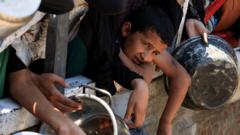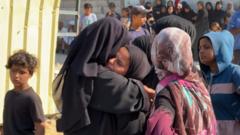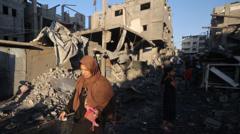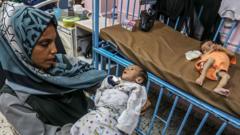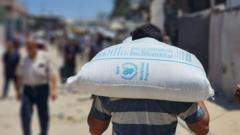As malnutrition rates soar in Gaza, concerns arise regarding the nutritional adequacy of food aid boxes from the Gaza Humanitarian Foundation, which provide insufficient vitamins and minerals essential for health.**
Nutritional Concerns Emerge Over GHF Food Aid Distribution in Gaza**
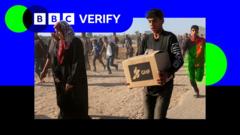
Nutritional Concerns Emerge Over GHF Food Aid Distribution in Gaza**
A breakdown of the contents and nutritional value of food aid boxes distributed by the Gaza Humanitarian Foundation highlights potential health risks.**
More than two million Palestinians in Gaza are currently facing an escalating starvation crisis, with malnutrition-related deaths increasing daily, according to the United Nations. The Gaza Humanitarian Foundation (GHF), with backing from Israel and the United States, has been distributing food aid since May, reportedly delivering around 91 million meals via food boxes. However, access to these boxes by international journalists has been restricted, prompting BBC Verify to analyze shared photos and consult aid experts about their contents and nutritional value.
Videos from the region have circulated showing the food boxes, but only limited images were provided by the GHF. The boxes reportedly contain primarily dried food items that need water and fuel for preparation, including staples like pasta, chickpeas, lentils, and wheat flour. Additionally, they include cooking oil, salt, tahini, and some ready-to-eat options such as halva bars. The GHF claims that each typical box contains approximately 42,500 calories and is designed to feed 5.5 individuals for 3.5 days.
Despite this caloric provision, experts have raised alarms regarding the nutritional shortcomings of the aid. Professor Stuart Gordon from the London School of Economics noted that while the boxes could help meet immediate caloric needs, they lack essential nutrients that contribute to overall health. He described it as a "first aid" response that could lead to long-term deficiencies associated with diseases like anaemia and scurvy if consumed regularly.
Dr. Andrew Seal from University College London pointed out that the food boxes miss critical dietary elements, including calcium, iron, zinc, and various vitamins. He further criticized the absence of suitable food for young children, suggesting that such diets could lead to serious health issues if sustained over time. Unlike the GHF, humanitarian agencies like the UN typically distribute foods in bulk along with targeted nutritional supplements aimed at vulnerable populations.
Notably, individuals attempting to prepare the dried goods receive additional challenges due to an ongoing water crisis and severe fuel shortages in Gaza. The UN's Office of Humanitarian Affairs has highlighted the deteriorating conditions, warning that families have turned to unsafe cooking practices due to limited resources. Meanwhile, the World Food Programme reported that cooking gas has vanished from legal channels, with those seeking it facing exorbitant black market prices.
UN Secretary General António Guterres reiterated the dire situation in Gaza, stating that severe shortages are leading to a sharp rise in malnutrition, affecting nearly one in three individuals who sometimes go without food. The World Food Programme has indicated that 90,000 women and children urgently require treatment for malnutrition.

